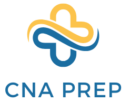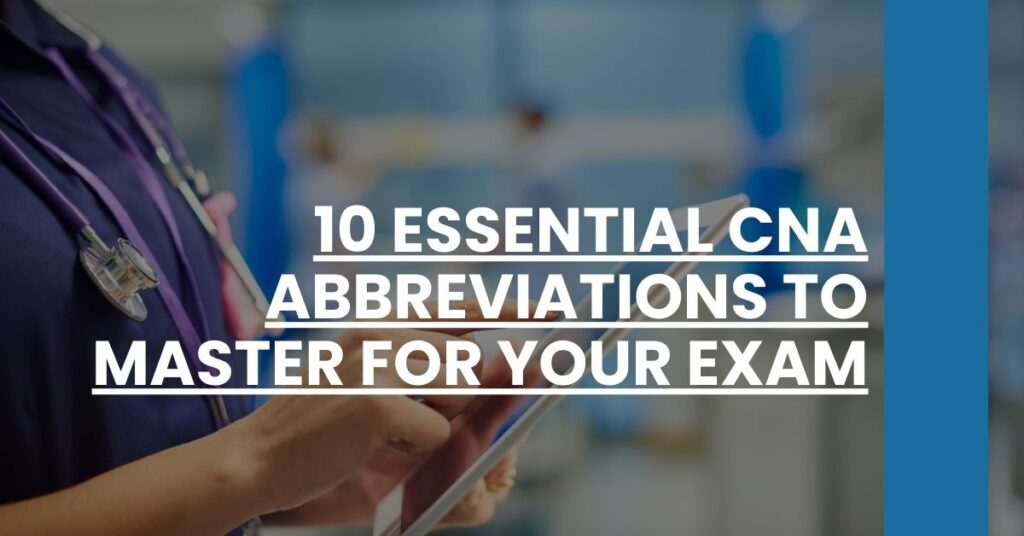Ever felt puzzled by the myriad of medical shorthand you’ll need to master for the CNA abbreviations exam? Fear not!
This post distills the essentials, offering a strategic guide through the abbreviations that stand as gatekeepers to your certification.
These are the terms and tricks that will support you in translating acronyms into success, ensuring your skills are both exam-ready and clinically sharp.
- 1. Understanding Common Healthcare Abbreviations
- 2. Importance of Accuracy in Abbreviation Usage
- 3. Memorization Techniques for Abbreviations
- 4. Top 10 Abbreviations on the CNA Exam
- 5. Medical Terminology Essentials
- 6. Practice With Real-World Scenarios
- 7. Time Management During the Exam
- 8. Technological Aids in Learning Abbreviations
- 9. Test-Taking Strategies for Abbreviation Questions
- 10. Refreshing Knowledge Post-Exam
- Related Topic: Patient Communication Skills
- Related Topic: Legal Implications of Abbreviations
- Conclusion: Preparing for your CNA Abbreviations Exam
1. Understanding Common Healthcare Abbreviations
As a Certified Nursing Assistant (CNA), mastering various healthcare abbreviations isn’t just a requisite for your upcoming cna abbreviations exam; it’s the bedrock of effective communication in your daily duties. These shorthand notations are the language of healthcare professionals that enable quick and accurate information exchanges—vital for patient care.
Imagine being on a bustling ward with physicians and nurses reliant on your updates. Using abbreviations correctly ensures that everyone is on the same page without losing precious time. For instance, knowing that BID means “twice a day” is crucial when updating a medication chart, while understanding PRN (as needed) could govern the urgency with which you administer care.
Let’s delve into the significance of abbreviations you’ll encounter:
- AC (Before Meals): Recognizing this ensures patients receive insulin or other meds at the optimal time.
- BP (Blood Pressure): An everyday metric for patient monitoring.
- NPO (Nothing by Mouth): Indicates when a patient should not ingest anything, typically before surgery or certain tests.
Your grasp of these abbreviations must be precise because, in healthcare, nuance matters. (Here’s some additional insight on communication in healthcare.) As you encounter these abbreviations frequently, they’ll become second nature, streamlining your workflow and boosting your confidence—especially when the pressure is on.
2. Importance of Accuracy in Abbreviation Usage
Accuracy in healthcare is not just about correctness; it’s a matter of safety. The realm of CNA abbreviations is no exception. In your cna abbreviations exam and your professional life, precision can be the difference between positive outcomes and preventable errors. This reality was underscored by a study that revealed the potential harm stemming from misunderstood abbreviations, such as misreading QD (once daily) as QID (four times daily)—a potentially catastrophic mix-up.
Think about the weighty responsibility on your shoulders: simple notation like HS (at bedtime) informs the timing of medications, and a mix-up could disrupt a patient’s therapeutic regimen. Therefore, honing an exact understanding of abbreviations not only readies you for the exam but safeguards your patients’ well-being.
Let’s outline the practices for flawless abbreviation use:
- Always refer to the approved list of abbreviations provided by your institution.
- Double-check dosages and times when notations appear ambiguous.
- Practice clear and legible handwriting to prevent misinterpretations.
(Fascinating details on this subject can be found in why medical terminology is important.)
3. Memorization Techniques for Abbreviations
Memorizing can often feel daunting, but fear not. Effective memorization techniques can make absorbing CNA abbreviations for your exam a breeze. Your brain is a muscle, and like any muscle, it benefits from varied and consistent training. Did you know that mixing up the ways in which you learn can significantly aid memorization? Yes, from flashcards to mnemonic devices, diversifying your techniques is key (here’s a peek into brain-based retention strategies).
Sharpen your memory with these strategies:
- Use mnemonic devices: Link abbreviations with familiar phrases or words to create associations.
- Flashcards: They provide repetitive, active recall—a proven memorization method.
- Study groups: Discussing and teaching one another can uncover new mnemonic strategies and solidify recall.
- Regular testing: Self-quizzes help you to identify gaps in your knowledge.
Above all, consistency is your strongest ally. Allocating daily time slots to your studies drums information into your long-term memory, paving the way for exam success and excellent caregiving.
4. Top 10 Abbreviations on the CNA Exam
Let’s focus on the core of the matter—the top 10 abbreviations you absolutely must have down pat for your cna abbreviations exam:
- ADLs (Activities of Daily Living)
- BM (Bowel Movement)
- BP (Blood Pressure)
- CPR (Cardiopulmonary Resuscitation)
- I&O (Intake and Output)
- IV (Intravenous)
- NPO (Nothing by Mouth)
- PRN (When Necessary)
- SOB (Shortness of Breath)
- TID (Three Times a Day)
These abbreviations are your alphabet in the healthcare language. They’re the cornerstones around which much of your caregiving and communication revolve.
5. Medical Terminology Essentials
Solidifying your knowledge of medical terminology adds depth to your understanding of CNA abbreviations. The anatomy of medical language is complex, but a methodical approach to learning roots, suffixes, and prefixes of terms can illuminate the meanings of many abbreviations you’ll encounter on your exam.
For instance:
- Cardi/o stands for “heart,” so CP (Chest Pain) in your documentation directly signals an issue with the heart.
- Gastr/o means “stomach,” therefore, GB (Gallbladder) is related to the digestive system.
Understanding these linguistic components enhances your ability as a CNA to anticipate needs and interpret information accurately, making you an invaluable asset to any healthcare team. For more insights, check out a useful overview on common CNA medical terminology.
6. Practice With Real-World Scenarios
It’s one thing to know your abbreviations by the book, really mastering them comes from applying that knowledge to real-world scenarios. Imagine, during a hectic shift, deciphering a nurse’s note that reads “Patient exhibiting SOB, administer O2 STAT” – you understand instantly that a patient with shortness of breath requires immediate oxygen.
Incorporating abbreviations into simulated patient interactions, role-playing, or even virtual patient scenarios equips you to respond with accuracy and speed. These practices embed the abbreviations deeply into your cognitive processes – so they come to mind effortlessly when needed.
To really get the hang of it, consider exploring resources that pose practice questions and simulate caregiving situations (CNA practice tools can be an excellent asset). With diligent, applied practice, you’ll walk into your cna abbreviations exam – and later, your work environment – brimming with confidence.
7. Time Management During the Exam
In the tick-tock environment of your cna abbreviations exam, managing your minutes is as crucial as your understanding of medical shorthand. Isn’t it true that a watchful eye on the clock can sharpen your focus and help you allocate time efficiently across questions?
Here’s how you can keep pace and stay composed:
- Prioritize the Questions: Quickly skim through the test and identify questions you’re confident with. Answer these first to secure quick wins!
- Set Mini Deadlines: Allot specific time frames for each section to ensure steady progress throughout the exam.
- Practice Timing: While studying, time yourself answering abbreviation questions to build good habits before the actual test day.
Think of time management as a silent partner in your exam-taking strategy, continuously guiding you to maintain a robust and steady rhythm throughout the assessment.
8. Technological Aids in Learning Abbreviations
Say hello to your digital study buddies! With a plethora of apps and online platforms at your disposal, absorbing those CNA exam abbreviations can be less daunting and more efficient.
Embrace technology to supercharge your prep:
- Use Flashcard Apps: Digital flashcards offer interactive ways to memorize terms rapidly.
- Subscribe to Quiz Platforms: Online quizzes test your knowledge in a fun, game-like setting.
- Leverage Educational Software: Programs designed for medical students can offer comprehensive abbreviation tutorials.
Studies show these technological tools help to store information effectively.
9. Test-Taking Strategies for Abbreviation Questions
Striding confidently into your cna abbreviations exam is about being armed with proven strategies. Every question offers an opportunity to demonstrate your proficiency, each answer a step closer to passing.
To tackle abbreviation queries, consider these tips:
- Decipher the Context: Sometimes, understanding the situation can clue you in on the abbreviation in question.
- Eliminate Extremes: For multiple-choice questions, rule out the most unlikely options first.
- Stay Calm and Reasoned: If unsure, take a deep breath, and approach the question logically.
Having a clear strategy helps you navigate the trickiest of abbreviation questions with poise and certainty.
10. Refreshing Knowledge Post-Exam
The finish line of your cna abbreviations exam is just the beginning of your learning journey. Consider your certificate not as the end but the foundation upon which your career will evolve.
To stay current:
- Attend Workshops and Seminars: They often focus on the latest practices and terminology changes.
- Subscribe to Industry Publications: Regular reading keeps you informed about updates in healthcare lingoes.
- Engage in Peer Discussions: Colleagues may introduce you to emerging abbreviations and usage trends.
Consider lifelong learning as the cornerstone of your professional development, keeping your proficiency as a CNA fresh and relevant.
Related Topic: Patient Communication Skills
The fabric of healthcare is woven together by the threads of communication. It’s how you connect, care, and convey critical information to the patients relying on your expertise. Here’s the twist: effective communication harnesses the power of those CNA exam abbreviations to streamline and clarify patient interactions.
To hone your communication:
- Active Listening: Understand and empathize with patient concerns before responding.
- Clear Explanations: Translate abbreviations into layman’s terms to ensure understanding.
- Feedback Loops: Confirm comprehension through teach-back methods or follow-up questions.
Building strong patient communication skills does more than make your job easier—it personalizes the care journey for each individual in your care.
Related Topic: Legal Implications of Abbreviations
One might ask: what’s the legality of a few scribbled letters? Quite significant, in fact. The use of abbreviations extends beyond mere convenience to legal dimensions. An inaccurately used abbreviation could lead to misunderstandings with dire consequences, both clinically and legally.
To navigate the legal landscape:
- Adhere to Standard Abbreviations: Use only institutionally approved shorthand to minimize risk.
- Document Diligently: Ensure records are clear to any professional who may review them.
- Stay Updated: Regulations and best practices are constantly evolving; keep abreast of changes.
Your diligent use and understanding of abbreviations not only assure patient safety but also safeguard your career against legal pitfalls.
Conclusion: Preparing for your CNA Abbreviations Exam
There you have it—an arsenal of knowledge and strategies at the ready for your cna abbreviations exam. Embrace the nuances of medical shorthand with confidence, wield your memorization techniques fiercely, and let accurate, compassionate communication lead your way.
Remember, this exam is a stepping stone that launches you into a world where your skills make a tangible difference each day. And when you pass—and you will—you’ll join the ranks of healthcare heroes who deliver not just care, but hope and healing, one abbreviation at a time.

